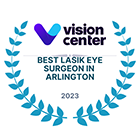Improve Your Reading Vision with Refractive Lens Surgery
Refractive lens exchange surgery, also called lens replacement surgery or clear lens extraction, uses an artificial lens to replace your eye’s clear natural lens. The replacement lens is called an intraocular lens or IOL, and is available in monofocal, multifocal, and accommodating focal lengths. The artificial intraocular lens is a permanent replacement for your natural lens and is designed to last the rest of your life.
Refractive lens exchange procedures are virtually identical to cataracts surgery. It is an elective procedure that can correct refractive eye issues, achieving sharper focus and reducing your need for reading glasses or contacts.
LASIK Surgery vs Refractive Lens Exchange
LASIK surgery and refractive lens exchange are similar, but with key differences. Where LASIK uses a laser to reshape the cornea, refractive lens surgery completely replaces the natural lens. Additionally, refractive lens exchange typically is for people with presbyopia (inability to read or see up close) or extreme farsightedness, that would not be a suitable candidate for LASIK, PRK or phakic IOL surgery. Depending on your vision needs and lifestyle, you may be better suited to one over the other. We highly recommend having a consultation with our eye doctors to determine which procedure is best four you.
Refractive Lens Surgery Cost
Because refractive lens exchange is considered an elective procedure, it’s often not covered by eye insurance. As an intraocular surgery, patients can expect to pay more than they might for something like LASIK surgery, about $2,300-$4,500 per eye.
Preparing for Refractive Lens Surgery
Because of its similarity to cataracts surgery, the preparation for refractive lens exchange follows similar guidelines:
- Stop taking certain medications (at the direction of your eye surgeon)
- Take antibiotic eye drops 1-2 days before (at the direction of your eye surgeon)
- Fast the night/day before your procedure
- Arrange a ride home
The actual replacement procedure usually takes 15-30, and each eye is typically done 1 week apart.
Refractive Lens Surgery Recovery
Most patients report immediate vision improvement after surgery. The full effect of the refractive lens exchange can take several weeks to be fully realized. Additionally, patients may notice vision disturbances such as blurry vision, glare, or dry, rough sensation as the eyes heal.
Patients should be able to return to work and resume driving within a week of surgery, depending on the eye surgeon's instructions.










.png)

